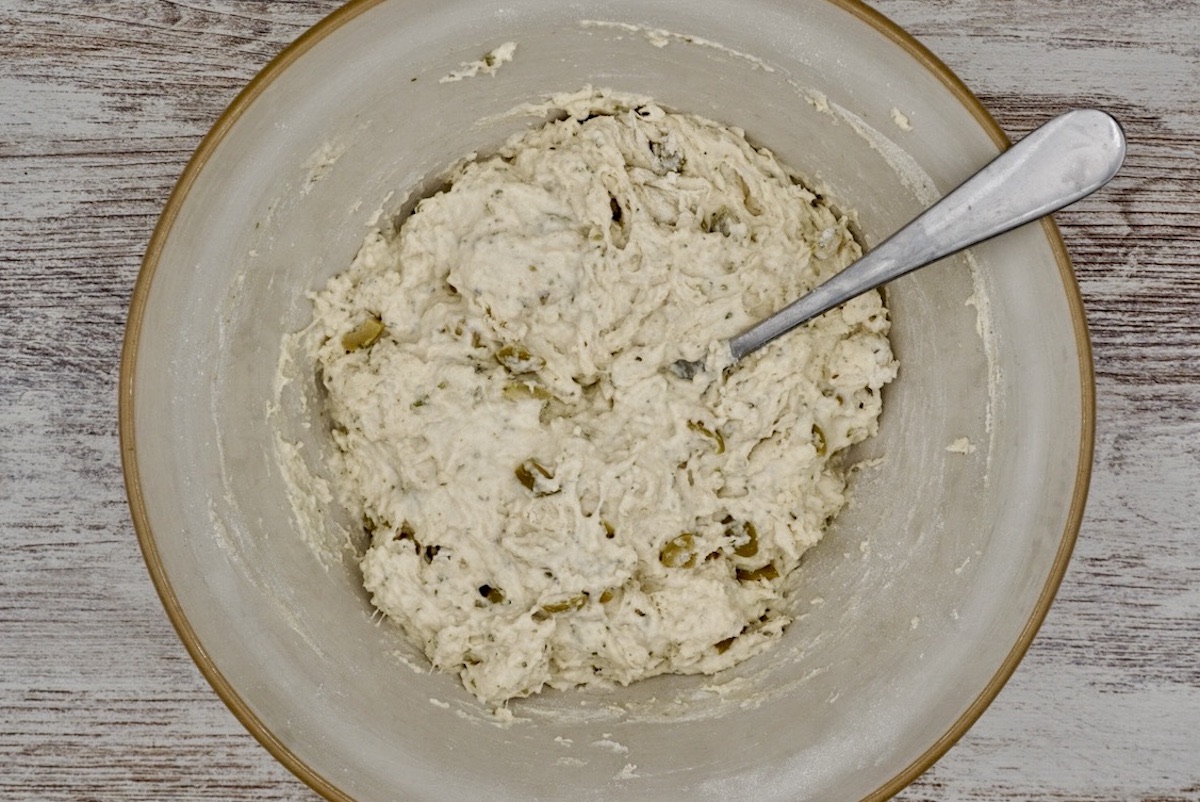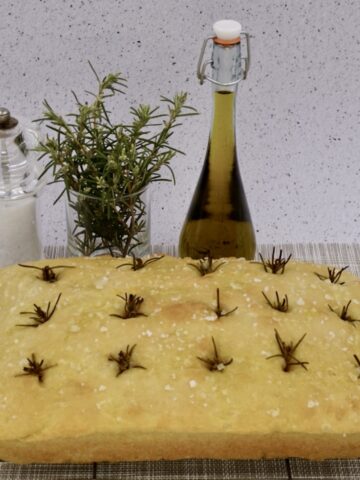Olive bread is a crusty, rustic bread which can be prepared with very little effort. The dough is prepared on day one and left to prove overnight before being baked in a Dutch oven the following day.

This easy bread recipe is suitable for beginners. There are no complicated steps and the dough does not require kneading.
Similar to no knead fruit bread, this overnight bread can be prepared with very little hands on time making it easy for you to make your own artisan style bread.
It is perfect served with pasta dishes such as cannelloni, vegetable pesto pasta or ravioli. It also pairs well with a variety of salads or can be served alongside a cheeseboard.
And if you have some easy bake yeast left over you could use it to make some cinnamon rolls, tear and share bread or apricot and cashew loaf.
This Dutch oven bread recipe will make a loaf which equates to around five servings.
Ingredients
- 400g bread flour - use a strong flour rather than plain flour (all purpose flour) with a protein content of 12% to 14% for flavour and texture. You will also need a little extra flour for shaping.
- 1.25 teaspoons salt
- 0.25 teaspoon easy bake yeast
- 325ml water - the water should be hand hot so that it is the correct temperature to activate the yeast.
- 100g pitted olives - you can use either green olives or black olives.
- 1 tablespoon dried oregano - if you don't have oregano you could substitute other herbs such as rosemary or basil.

Equipment needed
In addition to common kitchen equipment you will also need a cast iron pot with a well fitting cast iron lid (also known as a Dutch oven or French oven).
How to make no knead olive bread
DAY 1
Weigh the flour into a large bowl. Add the salt and easy bake yeast and mix.
Prepare the olives by rinsing and then patting dry with kitchen paper. You can use any type of olives, green or black. Roughly chop the olives (each olive into about 8 pieces) and then add to the bowl with the other ingredients and mix.
Measure 325ml hand hot water and add to the bowl with the other ingredients. The water should be a similar temperature to a hot bath and should still be hand hot at the time it is added to the other ingredients so that it will activate the yeast.
Mix everything together with a fork, cover with cling film and leave to cool.

Cover and leave in a warm place to rise until it has doubled in size.
Place in the fridge and leave overnight (or a minimum of 12 hours) to prove.
DAY 2
Remove the dough from the fridge before you wish to bake the loaf so that it can reach room temperature.

Tip the dough onto a lightly floured pastry board, fold over a few times by hand and form a ball.

How to bake
Pre heat the oven to 220oC, 425oF, gas mark 7. When the oven is almost at that temperature place the empty cast iron dish, with lid, in the oven to preheat.
Remove the preheated casserole dish from the oven and line the base with non-stick baking parchment. Transfer the dough into the lined dish. Use a sharp knife to slit the top of the bread dough.
Place the lid on the casserole dish and bake in the centre of the oven for about 30 minutes. Baking with the lid on will help to steam the bread and allow it to rise before the crust forms and the surface of the bread dries out.
Remove the lid and return to the oven for around 10 minutes until browned.
Remove from the dish and place on a wire cooling rack to cool.

How to serve
- Homemade olive bread is delicious served alongside many pasta dishes such as cannelloni, lasagne, ravioli or vegetable pesto pasta.
- It also pairs well with a variety of salads.
- Olive bread makes a tasty addition to a cheeseboard or vegetarian charcuterie board.
How to store
- Store your olive bread in an airtight container.
- As with most types of bread I find that this olive bread is at its best on the day it has been baked. I recommend freezing any bread that isn't going to be eaten the day it is baked.
- To freeze - place slices of olive bread in an airtight container such as a tub or bag. Defrost at room temperature or in a microwave.
FAQs
The Dutch oven method of baking bread is a method of baking bread in a cast iron pot with a lid. The bread is baked with the lid on for the first part of the baking time, during which moisture from the bread dough is released but retained in the pot. This allows the bread to rise without cracking. The lid is then removed for the final part of baking time to allow the bread to develop a beautiful golden crispy crust.
Olive bread pairs well with pasta dishes and salads. It also goes well with cheeseboards and dips.
Other easy bread recipes
- Rosemary focaccia2 Hours 40 Minutes
- Fruit bread (Dutch oven bread)14 Hours 55 Minutes
- Rosemary and olive rolls (tear and share)2 Hours 35 Minutes
- Hot cross buns (with easy bake yeast)2 Hours 45 Minutes


Olive bread (No knead Dutch oven bread)
Equipment
- Dutch oven or French oven
Ingredients
- 400 g bread flour
- 1.25 teaspoon salt
- 0.25 teaspoon easy bake yeast
- 100 g olives
- 325 ml water (hand hot)
Instructions
Day one
- Weigh the flour into a large bowl. Add the salt and easy bake yeast and mix.
- Rinse the olives and pat dry with kitchen paper. Roughly chop the olives and add to the bowl with the other ingredients and mix.
- Measure 325ml hand hot water, add to the other ingredients and mix well with a fork.
- Cover and leave in a warm place to rise until it has doubled in size.
- When it has cooled transfer to the fridge to prove overnight (or a minimum of 12 hours).
Day two
- Remove the dough from the fridge before you wish to bake your olive bread to allow it to reach room temperature.
- Preheat the oven to 220°C, 425°F, gas mark 7. When the oven is almost at this temperature place the cast iron dish, with lid, in the oven to preheat for a few minutes.
- Transfer the bread dough to a lightly floured pastry board. Fold the dough over a few times and then shape the dough into a ball.
- Remove the preheated dish from the oven and line the base with a small piece of non-stick baking parchment.
- Transfer the dough into the cast iron dish.
- Make three incisions to the top of the dough and then place the lid on the dish.
- Bake in the centre of the oven (with the lid on) for 30 minutes.
- Remove the lid and return to the oven for about 10 minutes or so until browned.
- Remove from the dish and place on a wire rack to cool.
Notes
- Homemade olive bread is delicious served alongside many pasta dishes such as cannelloni, lasagne, ravioli or vegetable pesto pasta.
- It also pairs well with a variety of salads.
- Olive bread makes a tasty addition to a cheeseboard or vegetarian charcuterie board.
- Store your olive bread in an airtight container.
- As with most types of bread I find that this olive bread is at its best on the day it has been baked. I recommend freezing any that which isn't going go to be eaten the day it is baked.
- To freeze - place slices of olive bread in an airtight container such as a tub or bag. Defrost at room temperature or in a microwave.









Emily
No-knead and with olives?? I’m in, love this recipe!!
Sue
I've never thought of making bread with olives in it, but now I can't wait to give it a try!
Michelle
WOW, this was one of the best bread recipes I've tried! Totally making this again!
Crystal
This bread is so delicious and easy to make! I love the addition of olives!
Cindy Mom the Lunch Lady
My family absolutely LOVES olives and I love how easy this bread was to make. I proofed it over night and baked it in the morning. I was so delicious with butter and cheese!
Jeannie
great flavors from the olives, tho I like kneading cause its relaxing it is also tiring, lol… this is perfect for me.
Gina Abernathy
I love homemade bread. My house always smells so good while it's baking and my tummy feels great while I'm eating it!
Katie
This recipe is perfection! Simple to make and perfect texture!
Nancy
Adding olives to bread actually really tastes good. Thanks for the recipe.
Bianca
This olive bread is amazing! Super easy to make and perfect for charcuterie boards